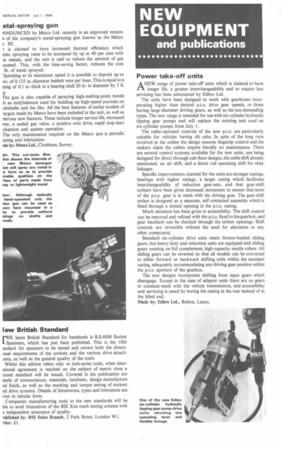NEW EQUIPMENT
Page 55

If you've noticed an error in this article please click here to report it so we can fix it.
and publications
etal-spraying gun
NINOUNCED by Metco Ltd. recently is an improved version L of the company's metal-spraying gun known as the Metco e 8E.
t is claimed to have increased thermal efficiency which mits spraying rates to be increased by up to 40 per cent with ic metals, and the unit is said to reduce the amount of gas tsumed. This, with the time-saving factor, reduces the cost lb. of metal sprayed.
Dperating at its maximum speed it is possible to deposit up to wt. of 0.125 in.-diameter babbitt wire per hour. This is equal to a ding of 0.1 in.-thick in a bearing shell 30 in. in diameter by 3 ft.
8.
The gun is also capable of spraying high-melting-point metals Is as molybdenum used for building up high-speed journals on nkshafts and the like. All the best features of earlier models of .aygun made by Metco have been included in the unit, as well as merous new features. These include longer service life, increased wer, a sealed gas valve, a positive wire drive, rapid stop-start ehanism and quieter operation.
The only maintenance required on the Metco gun is periodic aning and lubrication.
Ide by: Metco Ltd., Chobham, Surrey.
law British Standard
THE latest British Standard for handtools is B.S.4006 Socket I. Spanners, which has just been published. This is the 10th andard for spanners to be issued and covers both the dimenonal requirements of the sockets and the various drive attachents, as well as the general quality of the tools.
Whilst this edition refers only to inch-series tools, when interational agreement is reached on the subject of metric sizes a ;cond standard will be issued. Covered in the publication are etails of nomenclature, materials, hardness, design manufacture ad finish, as well as the marking and torque testing of sockets nd drive systems. Details of dimensions, types and tolerances are 'wen in tabular form.
Companies manufacturing tools to the new standards will be ble to avail themselves of the BSI Kite mark testing scheme with s independent assurance of quality.
'ublished by: BSI Sales Branch, 2 Park Street, London W I. 'rice: LI.
Power take-off units
NEW range of power take-off units which is claimed to have longer life, a greater interchangeability and to require less servicing has been announced by Edbro Ltd.
The units have been designed to work with gearboxes incorporating higher than desired p.t.o. drive gear speeds, or those having large-diameter driving gears, as well as the less demanding types. The new range is intended for use with six-cylinder hydraulic tipping gear pumps and will replace the existing unit used on six-cylinder pumps from July 1.
The cable-operated controls of the new p.t.o. are particularly suitable for vehicles having tilt cabs. In spite of the long runs involved in the cables the design ensures fingertip control and the makers claim the cables require literally no maintenance. There are several control systems available for the new units, one being designed for direct through-cab-floor designs, the cable shift already mentioned, an air shift, and a direct rod operating shift for relay linkages.
Specific improvements claimed for the units are stronger casings, bearings with higher ratings, a larger casing which facilitates interchangeability of reduction gear-sets, and that gear-shift strikers have been given increased movement to ensure that more of the p.t.o. gear is in mesh with the driving gear. The gear-shift striker is designed as a separate, self-contained assembly which is fitted through a slotted opening in the p.t.o. casing.
Much attention has been given to accessibility. The shift control can be removed and refitted with the p.t.o. fixed to the gearbox, and gear backlash can be checked through the striker openings. Shift controls are reversible without the need for alteration to any other component.
Standard six-cylinder drive units retain bronze-bushed sliding gears, but heavy-duty and reduction units are equipped with sliding gears running on full complement, high-capacity needle rollers. All sliding gears can he reversed so that all models can be converted to either forward or backward shifting units within the standard casing, adequately accommodating any driving-gear position within the p.t.o. aperture of the gearbox.
The new designs incorporate shifting front input gears which disengage. Except in the case of adapter units there are no gears in constant-mesh with the vehicle transmission, and accessibility and servicing is eased by boring the casing at the rear instead of at the blind end.
Made by: Edbro Ltd., Bolton, Lancs.




























































































































